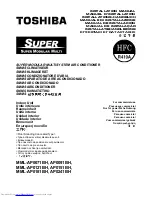
8
Indoor unit
Pipe side
(Required at the site)
Attached heat insulating pipe
Work using double spanner
• Projection margin in flaring : B (Unit : mm)
Rigid (Clutch type)
Outer diam. of
copper pipe
6.4
9.5
12.7
15.9
R410A tool used
R410A
R22
0 to 0.5 (Same as left)
0 to 0.5 (Same as left)
0 to 0.5 (Same as left)
0 to 0.5 (Same as left)
Conventional tool used
R410A
R22
1.0 to 1.5
0.5 to 1.0
1.0 to 1.5
0.5 to 1.0
1.0 to 1.5
0.5 to 1.0
1.0 to 1.5
0.5 to 1.0
Imperial (Wing nut type)
Outer diam. of copper pipe
6.4
9.5
12.7
15.9
R410A
R22
1.5 to 2.0
1.0 to 1.5
1.5 to 2.0
1.0 to 1.5
2.0 to 2.5
1.5 to 2.0
2.0 to 2.5
1.5 to 2.0
Connection of refrigerant pipe
Connect all the refrigerant pipes with flare connecting
work.
• Since the atmospheric pressure only is sealed as the
sealing gas, it is not abnormal that “Pushu…” sound
is not heard when the flare nut is removed.
• Be sure to use a double spanner for pipe connecting
work of the indoor unit.
• Refer to the following table for tightening torque.
Connecting pipe
outer dia. (mm)
Ø6.4
Ø9.5
Ø12.7
Ø15.9
Tightening torque
(N•m)
14 to 18
(1.4 to 1.8 kgf•m)
33 to 42
(3.3 to 4.2 kgf•m)
50 to 62
(5.0 to 6.2 kgf•m)
68 to 82
(6.8 to 8.2 kgf•m)
Re-tightening
torque (N•m)
18
(1.8 kgf•m)
42
(4.2 kgf•m)
50
(5.0 kgf•m)
68
(6.8 kgf•m)
Airtight test/Air purge, etc.
For airtight test, air purge, addition of refrigerant, and
gas leak check, follow the Installation Manual attached
to the outdoor unit.
Open fully valves of the outdoor unit
Gas leak check
Check with a leak detector or soap water whether gas
leaks or not, from the pipe connecting section or cap
of the valve.
REQUIREMENT
Use a leak detector manufactured exclusively for
HFC refrigerant (R410A, R134a, etc.).
Heat insulating process
Perform heat insulating for pipes at liquid side and gas
side separately.
In cooling time, temperature at both liquid and gas
sides becomes lower.
Therefore, perform heat insulating process sufficiently
to avoid dewing.
• For heat insulator of pipe at gas side, be sure to use
one with heat-resisting temp.120°C or more.
• Using the attached heat insulating pipe, perform heat
insulating process securely for pipe connecting part
of the indoor units without clearance.
REQUIREMENT
Apply the thermal insulation to the pipe connecting
section of the indoor unit securely up to the root
without exposure of the pipe. (The pipe exposed to
the outside causes water leak.)












































